#༺⛧༻ 𝕮𝔞𝔫𝔢𝔰 𝖁𝔢𝔫𝔞𝔱𝔦𝔠𝔦 ༺⛧༻
Text
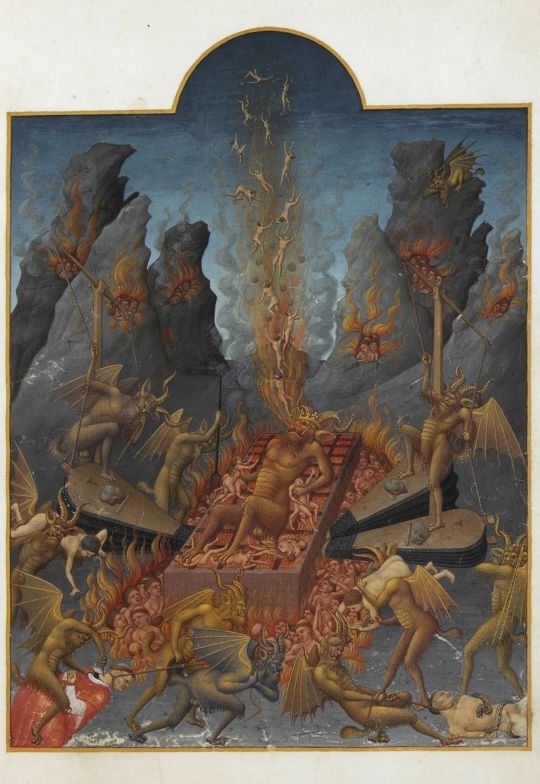
Folio 108r - Hell

This piece of Medieval Gothic art was created by the Limbourg Brothers - Herman, Paul, and Jean de Limbourg (active in France by 1399, died by 1416). It depicts Lucifer in hell, torturing the souls and being tortured himself.
The Devil is shown to be laying on top of a large grill and throwing souls of the deceased into the air with the might of his burning breath. Two demons are on the sides, blowing air under the grill to keep the flames burning. Others inflict harm on mortal souls, including that of a monk still wearing his vestments.
#༺⛧༻ 𝕮𝔞𝔫𝔢𝔰 𝖁𝔢𝔫𝔞𝔱𝔦𝔠𝔦 ༺⛧༻#༺⚚༻ 𝕲𝔞𝔩𝔩𝔢𝔯𝔦𝔞 ༺⚚༻#art#art history#medieval art#gothic art#hell#lucifer#satan#limbourg brothers
190 notes
·
View notes
Text
I believe Ciel is meant to die.
As much as I enjoy theories and headcanons that dwell on the possibility of him joining Sebastian in the afterlife, I do believe that the canon tragedy of Ciel Phantomhive is that he is not meant to survive; he is virtually already dead. He has bought himself time with the soul of his brother, and there will be a moment this time comes down to an end.
I find it interesting that currently Ciel, who is inevitably moving towards his fated end, is opposed to his brother - someone whose very existence is not meant to be: Undertaker is desperately trying to keep him alive despite Ciel's brother and Ciel himself being already dead, even if for one of them it is delayed. In a way, they both belong to Sebastian, but only one of them is food worth savoring.
Some part of this makes me think of the predatorial nature of Sebastian's care for Ciel. This boy who has built himself out of nothing, created a name for himself, and has established his reign - this boy is finally a priority for someone, and this someone craves to consume him.
Ciel is Sebastian's first and only choice, and this, being a personal delicacy of a demon, is exactly why Ciel is granted the chance to have a life he always wanted, life of the favored heir.
Alas, it is also the reason why Ciel is not meant to survive: he is Sebastian's, and the demon prefers him too strongly.
#༺⛧༻ 𝕮𝔞𝔫𝔢𝔰 𝖁𝔢𝔫𝔞𝔱𝔦𝔠𝔦 ༺⛧༻#༺♜༻ 𝕯𝔦𝔞𝔟𝔬𝔩𝔦𝔠𝔬 ༺♜༻#kuroshitsuji#black butler#black butler meta#ciel phantomhive#sebastian michaelis
188 notes
·
View notes
Text
Sebastian is a very unusual protagonist because while he is a powerful entity, he also seems to be a relatively inexperienced demon - at the very least in the beginning of the manga.
He encounters Ciel as someone who is skillful at manipulation, killing, seduction - that is true. However, his abilities in terms of managing household, knowing how to treat human illnesses as well as his general knowledge about how human beings work, what they like their food to taste like, and more seem to be lacking.
A demon that needs to actively learn from his Master, read books to understand Victorian medicine, and repeatedly go through failures before he grasps certain concepts is not a typical character to encounter in supernatural media. Usually, entities are portrayed as omniscient, omnipotent, and omnipresent, but Sebastian does not seem to fit those criteria: he simply lacks knowledge a truly Ancient being would possess.
He is seemingly weaker than some of the reapers, he gets injured, he makes mistakes. He does not fit the archetype of a "primordial entity with excessive powers" because he learns how to be a perfect butler alongside his Master who is growing into being a proper Earl.
#༺⛧༻ 𝕮𝔞𝔫𝔢𝔰 𝖁𝔢𝔫𝔞𝔱𝔦𝔠𝔦 ༺⛧༻#༺♜༻ 𝕯𝔦𝔞𝔟𝔬𝔩𝔦𝔠𝔬 ༺♜༻#kuroshitsuji#black butler#black butler meta#sebastian michaelis
167 notes
·
View notes
Text


A Preserved Human Heart used for Anatomical Study

This preserved anatomical heart, labeled to date back to 1859, comes from the collection of Finch and Co Antiques in London. It is contained under a glass dome on an ebony base.
#༺⛧༻ 𝕮𝔞𝔫𝔢𝔰 𝖁𝔢𝔫𝔞𝔱𝔦𝔠𝔦 ༺⛧༻#༺⚿༻ 𝕾𝔱𝔬𝔯𝔦𝔞 ༺⚿༻#history#antiques#antique#victorian history#anatomy#anatomical heart#real heart#victorian#heart
135 notes
·
View notes
Text

The Pelican in her Piety

This enamelled gold Spanish pendant was made in approximately 1550 - 1575 and is adorned with pearls and a ruby simulant. Its concept refers to a Medieval fable of the pelican drawing blood from its own breast to feed its young. The imagery is traditionally used to symbolize the Savior sacrificing himself on the Cross.
The pendant used to be in the Treasury of the Cathedral of the Virgin of the Pillar in Saragossa, Spain.
#༺⛧༻ 𝕮𝔞𝔫𝔢𝔰 𝖁𝔢𝔫𝔞𝔱𝔦𝔠𝔦 ༺⛧༻#༺✧༻ 𝕸𝔢𝔪𝔬𝔯𝔦𝔞 ༺✧༻#art#art history#v&a museum#victoria and albert museum#16th century#gold pendant
67 notes
·
View notes
Text

"For though this appeare a proper pulpet peece, yet whan the fox preacheth, then beware your geese."

This proverb, one of many from the Collection by John Heywood (1497-1580), is descriptive of the common imagery seen in many examples of Medieval art: a fox, dressed as a monk, is preaching to a flock of oblivious geese.
On this spoon, which dates back to 1430 and presents an example of South Netherlandish Gothic art, a similar scene is depicted: a fox, disguised as a monk, is carrying three dead geese on its back - in its hand, there's a scroll or another document with the word "pax", peace. The second fox is seizing the geese as they are being distracted by the fox priest.
Pieces such as this one were often created during the Medieval Times to mock the hypocrisy of the church and the clergy, which preached to the masses they prey on.
This specific object might have been made for Philip the Good, Duke of Burgundy and a great patron of arts.
#༺⛧༻ 𝕮𝔞𝔫𝔢𝔰 𝖁𝔢𝔫𝔞𝔱𝔦𝔠𝔦 ༺⛧༻#༺✧༻ 𝕸𝔢𝔪𝔬𝔯𝔦𝔞 ༺✧༻#history#art#antiquities#netherlandish art#medieval art#middle ages#religious art#mfa boston
93 notes
·
View notes
Text
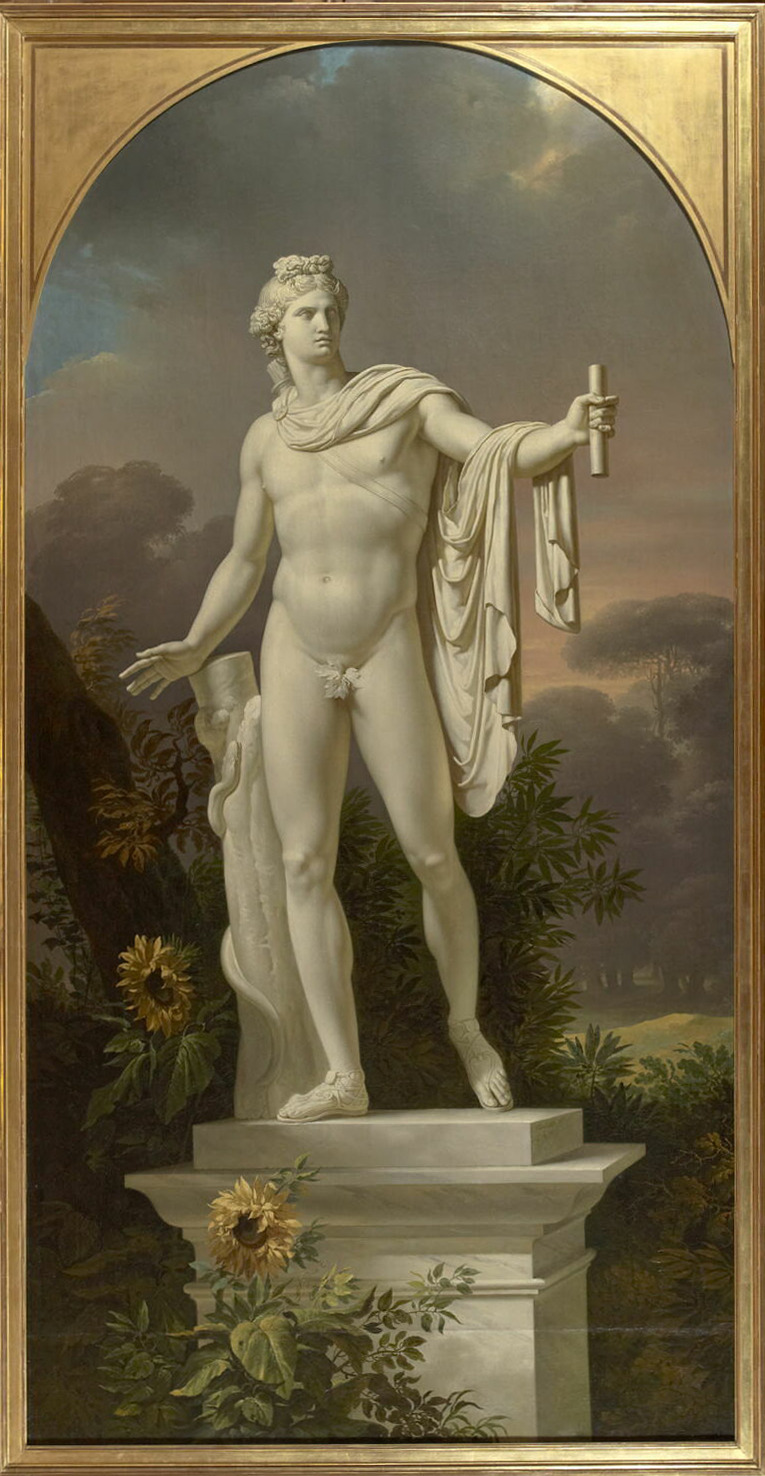
Statue d'Apollon (Apollon du Belvédère)

Painted by the French artist Charles Meynier (1768-1832) in either 1794 or 1795, this oil on canvas artwork depicts the statue of Apollo Belvedere, one of the most famous statues of the Ancient God.
It is 3 meters in height and 1.53 meters in width, towering over the viewer.
The gallery of art created by Meynier is full of other examples of paintings based off Ancient legends, myths, and stories.
#༺⛧༻ 𝕮𝔞𝔫𝔢𝔰 𝖁𝔢𝔫𝔞𝔱𝔦𝔠𝔦 ༺⛧༻#༺⚚༻ 𝕲𝔞𝔩𝔩𝔢𝔯𝔦𝔞 ༺⚚༻#art#greek gods#greek mythology#apollo#apollo belvedere#Charles Meynier#french art#french artist#tagamemnon
77 notes
·
View notes
Text

Satan as the Fallen Angel

Painted by Sir Thomas Lawrence (1769-1830) in red, white, and black chalk, this creation of phenomenal artistic mastery is a part of a larger group of art pieces. The full collection consists of six different paintings depicting scenes and characters from Milton's Paradise Lost. One is currently at the Royal Academy of Arts, one at Louvre, one in Private Collection, and two are lost.
Satan in this depiction stands in his full humanised glory - imagery typical of the late 18th century Romanticism when the fallen angel lost his beastly, animalistic appearance in art. His features here remind one more of David or Apollo Belvedere in his majestic, heavenly beauty caught right before the fall.
#༺⛧༻ 𝕮𝔞𝔫𝔢𝔰 𝖁𝔢𝔫𝔞𝔱𝔦𝔠𝔦 ༺⛧༻#༺⚚༻ 𝕲𝔞𝔩𝔩𝔢𝔯𝔦𝔞 ༺⚚༻#art#english art#english painter#english romanticism#romanticism#Sir Thomas Lawrence#18th century#satan#lucifer#paradise lost
122 notes
·
View notes
Text
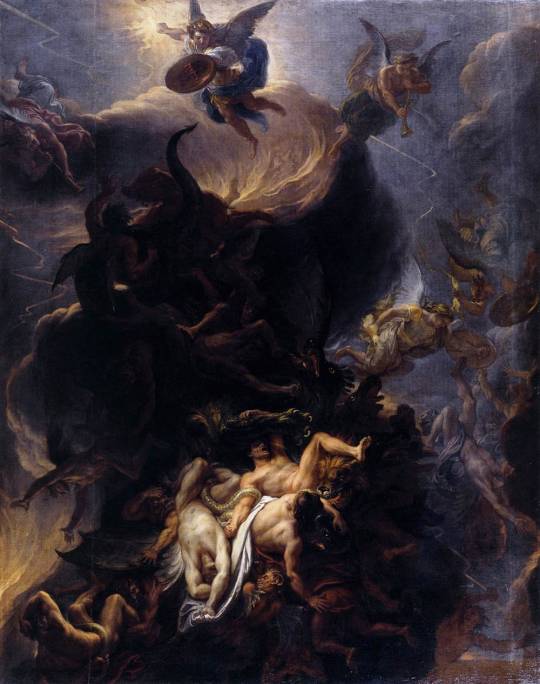
The Fall of the Rebel Angels

Created by Charles Le Brun (1619-1690), a French painter, this artpiece was designed to decorate the ceiling of the chapel within the Palace of Versaiiles, though this plan was never realized.
#༺⛧༻ 𝕮𝔞𝔫𝔢𝔰 𝖁𝔢𝔫𝔞𝔱𝔦𝔠𝔦 ༺⛧༻#༺⚚༻ 𝕲𝔞𝔩𝔩𝔢𝔯𝔦𝔞 ༺⚚༻#art#art history#history#french art#Charles Le Brun#angels#biblical#religious art#17th century
61 notes
·
View notes
Text
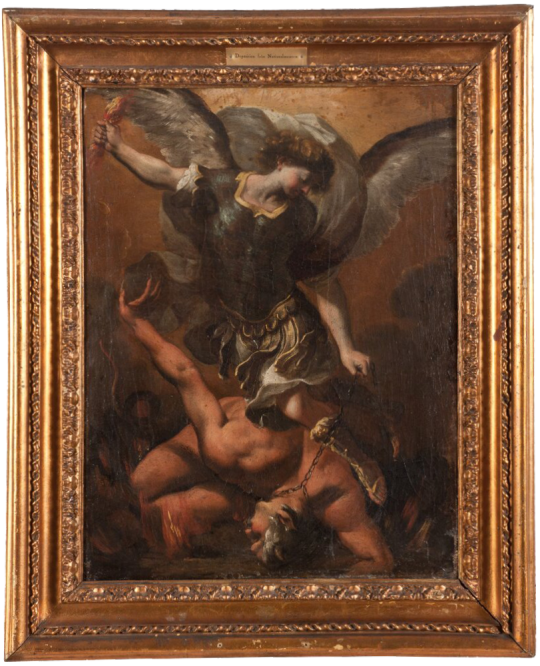
The Archangel Michael Defeating Satan

This beautiful painting is a copy likely created in the 16th-17th century after Cristofano Roncalli (1552 – 1626) also known as il Pomarancio, an Italian painter of the 16th century.
The artwork is done in oil on canvas and depicts a famous scene of archangel Michael bringing down Satan.
#༺⛧༻ 𝕮𝔞𝔫𝔢𝔰 𝖁𝔢𝔫𝔞𝔱𝔦𝔠𝔦 ༺⛧༻#༺⚚༻ 𝕲𝔞𝔩𝔩𝔢𝔯𝔦𝔞 ༺⚚༻#Cristofano Roncalli#art#art history#italian art#religious art#archangel michael#satan#16th century#17th century
19 notes
·
View notes
Text


The Demon Flying & The Fallen Demon

These two paintings (1899, 1902) have been created by Mikhail Aleksandrovich Vrubel, one of the main artists of the Russian Symbolist tradition and a pioneer of Modernist art.
Vrubel explored the "demonic" theme in multiple paintings, starting with his Demon that depicted the main character of Mikhail Lermontov's poem by the same name. The Demon Flying and The Fallen Demon are a continuation of the same topic within his art, though now also partially inspired by Alexander Pushkin's The Prophet.
#༺⛧༻ 𝕮𝔞𝔫𝔢𝔰 𝖁𝔢𝔫𝔞𝔱𝔦𝔠𝔦 ༺⛧༻#༺⚚༻ 𝕲𝔞𝔩𝔩𝔢𝔯𝔦𝔞 ༺⚚༻#art#russian art#russian artist#19th century#symbolism#symbolist art#modernism#modernist art#Mikhail Vrubel#demons
26 notes
·
View notes
Text

L’angelo annunciante
Angel of Annunciation
Part of the Polittico Averoldi - Averoldi Polyptych (1520–1522) by Tiziano Vecellio, aka Titian, Italian Renaissance painter. The entire polyptych was commissioned by Venetian papal legate Altobello Averoldi. The angel, specifically Archangel Gabriel depicted above, is one of five, as the name suggests, paintings comprising the altar piece. The other four are: I santi Nazaro e Celso con il donatore, La Vergine annunciata, Il Cristo risorto, and Il san Sebastiano.
Archangel Gabriel is holding up a scroll that says Ave Gratia Plena, which translates to Hail full of grace - the first words uttered by Gabriel to Virgin Mary.
The polyptych is displayed at Santi Nazaro e Celso, Brescia.

#༺⛧༻ 𝕮𝔞𝔫𝔢𝔰 𝖁𝔢𝔫𝔞𝔱𝔦𝔠𝔦 ༺⛧༻#༺⚚༻ 𝕲𝔞𝔩𝔩𝔢𝔯𝔦𝔞 ༺⚚༻#renaissance art#italian art#averoldi polyptych#archangel gabriel#titian#Tiziano Vecellio
23 notes
·
View notes
Text
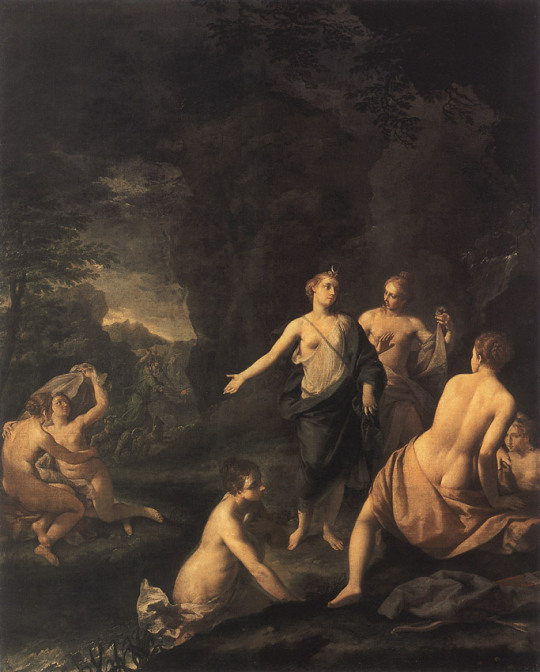
Diana and Actaeon

This painting depicts a famous mythological narrative about the hunter Actaeon bursting in when Diana and her nymphs are bathing. It was created by the renown Italian painter Ercole Graziani (1688—1765) who is remembered as a great master of Baroque art that inspired many pupils during his work in Bologna and Piacenza.
#༺⛧༻ 𝕮𝔞𝔫𝔢𝔰 𝖁𝔢𝔫𝔞𝔱𝔦𝔠𝔦 ༺⛧༻#༺⚚༻ 𝕲𝔞𝔩𝔩𝔢𝔯𝔦𝔞 ༺⚚༻#art#italian art#baroque art#Ercole Graziani#mythology#greek mythology#roman mythology#Diana#Artemis#Actaeon#tagamemnon
22 notes
·
View notes
Text

Latone et les paysans by Gabriel Guay

This 1877 painting by Gabriel Guay (1848–1923) depicts Latona, also known as Leto, an ancient Mediterranean Goddess of pre-Hellenic origin. She is portrayed holding two children, most likely Apollo and Artemis, other Mediterranean divinities, and greeting the working peasants.
In the stories told by Antoninus Liberalis a Greek mythographer, and Ovid, a Roman writer, Latona travels to Lycia, the land oftentimes attested as her country of belonging. There, she attempts to bathe the newborn children, Apollo and Artemis, who are most known to be twins following a later tradition but in early sources aren't born at the same time. When the Goddess is denied by the local peasants, she turns them into frogs. This art follows the famous story.
#༺⛧༻ 𝕮𝔞𝔫𝔢𝔰 𝖁𝔢𝔫𝔞𝔱𝔦𝔠𝔦 ༺⛧༻#༺⚚༻ 𝕲𝔞𝔩𝔩𝔢𝔯𝔦𝔞 ༺⚚༻#art#art history#mediterranean gods#french artist#french art#latona#apollo#artemis
14 notes
·
View notes
Text
♞ · θυσία
𝕬 union of sacrilege etched into the skin, marking territory and bleeding through the cuts, an impious act of longing to tie between flesh, weaving two into one. 𝕿ruth the color of pomegranate seeds: through taste, a bond is born; bloody red still raw on your tongue.
𝕳ungry 𝕲ods demand offerings, and you're a ravenous thing.
16 notes
·
View notes
Text
𝕳e's as close to perfection as one can get without ascending to divinity of falling for one's infernal demise. 𝕬 blessing and a curse in all ways measured, a precious gift 𝕴 was too corrupted to receive; an angel in the marble longing to be set free.
𝕬 thing to adore, to watch, to worship - something elusive and escapist, avoidant in all ways a wild doe is avoidant of the hunter.
𝕴 cannot think of anyone 𝕴'd be as fascinated with as him.
6 notes
·
View notes